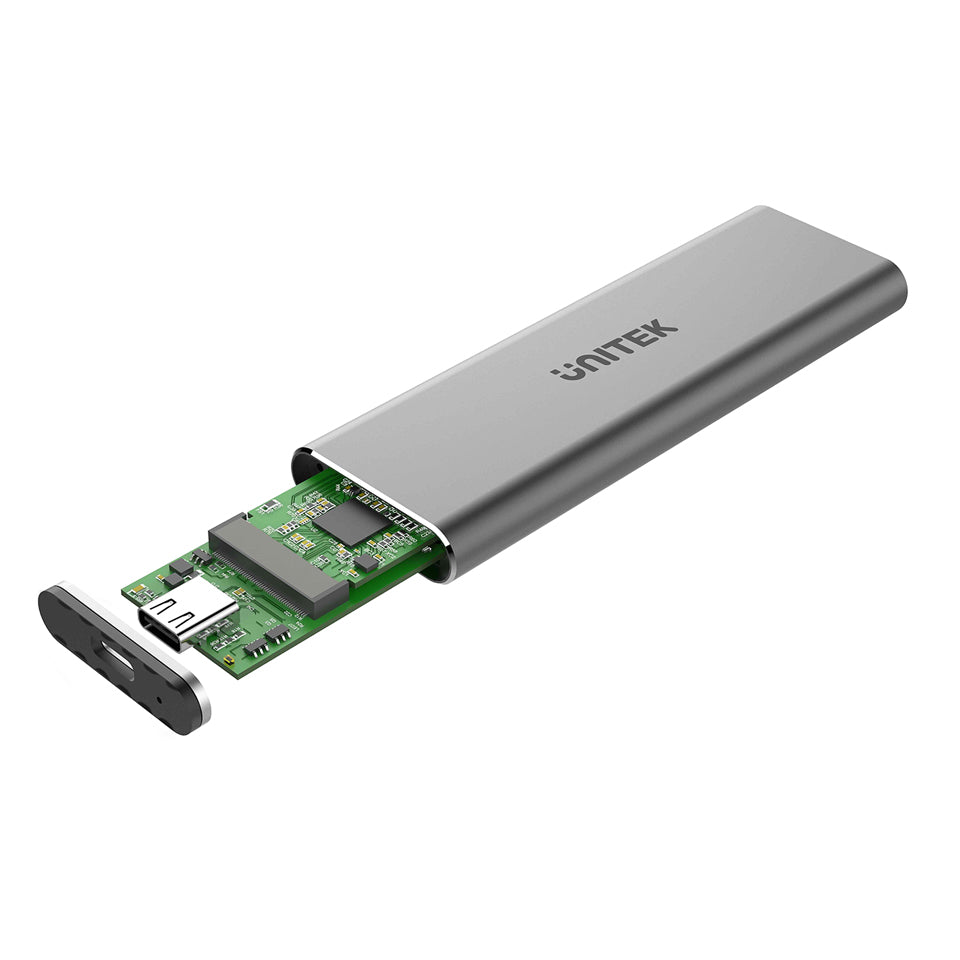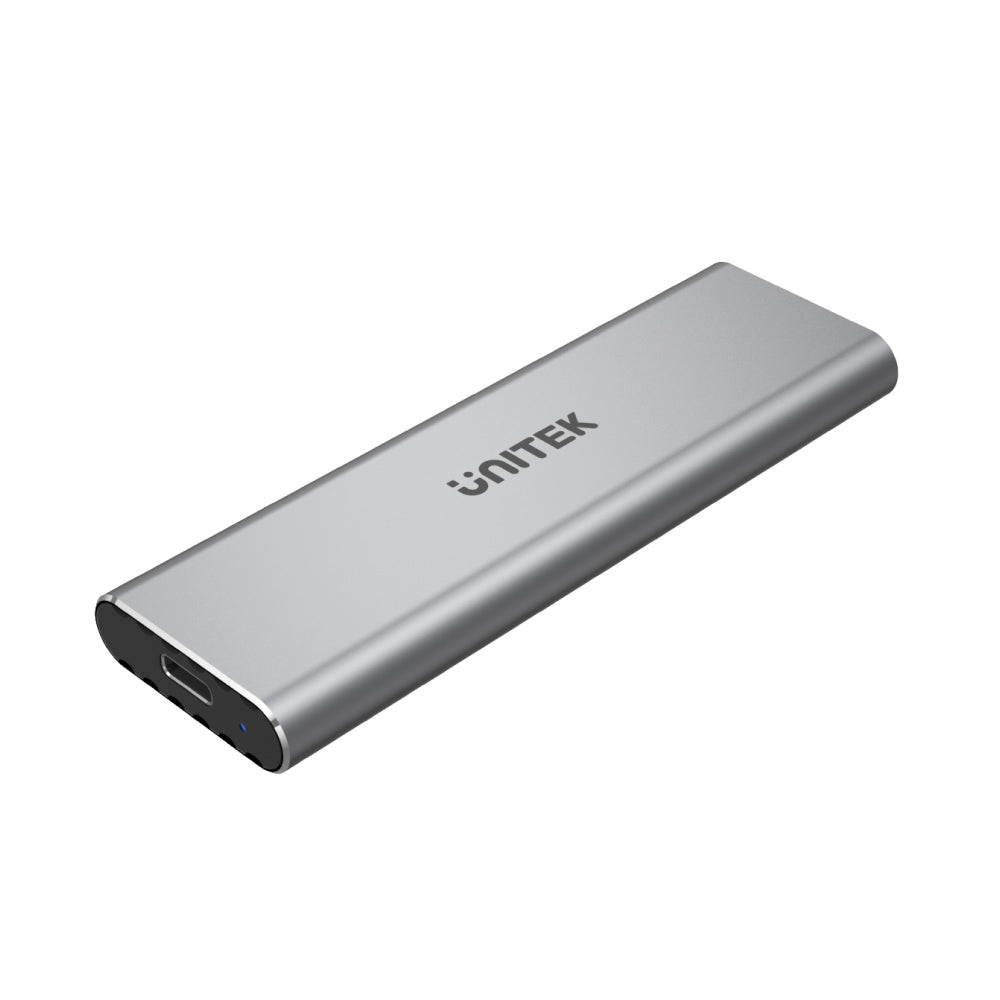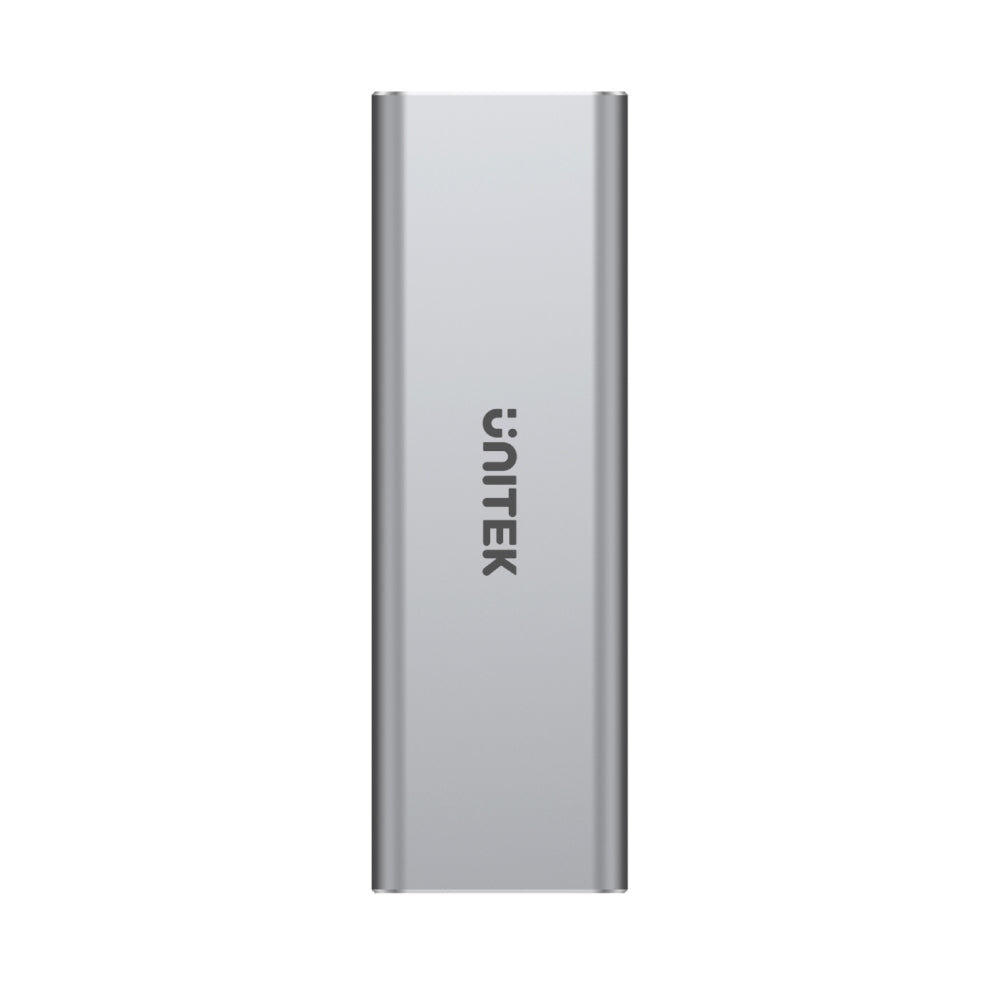


PCIe/NVMe M.2 SSD 10Gbps Enclosure
Suitable SSD:
This M.2 SSD Enclosure only for M.2 NVMe PCIe M-Key & B+M Key SSD. Applicable to sizes 2230/2242/2260/2280 solid-state drives. Does not support M.2 SATA-based SSDs, M.2 PCIe AHCI SSDs, M.2 PCIe devices such as WiFi and capture cards, mSATA SSDs, and non-M.2 form factor SSDs.
High Speed:
With USB 3.2 Gen 2 interface, supports up to 10Gbps data transfer speed. It's a reversible plug connector, easy to plug in and out. Backward compatible with USB 3.0 and USB 2.0.
How to Install M.2 SSD:
1. Remove the screw.
2. Remove the cover.
3. Remove cover and pull out the PCBA.
4. Insert M.2 SSD to PCIe/NVMe slot.
5. Press M.2 SSD down and match the screw slot.
6. Lock M.2 SSD with the screw.
| Upstream | USB-C (Male) |
| Downstream | M.2 (Female) |
| Product Color | Space Grey |
| Cable Length | 30 cm |
| Product Dimension | 108 x 37 x 9mm |
1 x USB3.1 Gen2 Type-C to M.2 SSD (PCIe/NVMe) Enclosure
1 x USB-C (M) to USB-C (M) Data Cable
1 x Screw (for M.2 SSD)
4 x Screw (for Enclosure)
1 x Mini Screw Driver
Shipping cost will be calculated during checkout. International duties & taxes may apply and are not calculated at checkout.
Shipping & Delivery
For shipping quotes, "Checkout" the item you want to buy, enter your shipping details and the shipping rates will automatically generate based on the item's weight and the delivery location.
If the shipping rates do not generate, please contact us.
Normal Shipping Times: 3-14 business days
The final shipping days depend on local logistics and transportation times.
Delays:
Unitek is not responsible for delays in shipping caused by extraneous factors (such as incorrect addresses, weather, inspections, labor disputes, and/or transportation problems). We cannot be responsible for lost or damaged packages.
Duties & Taxes:
Orders shipped outside of the United States may be subject to import taxes, customs duties, fees, and/or VAT (Value Added Taxes) levied by the destination country. You are responsible for paying any taxes, duties, customs fees, and/or VAT charged by your government, as UNITEK has no control over these charges and cannot predict what they may be. Please contact the local customs office in the relevant jurisdiction for additional information on customs policies or duties. International orders will not be refunded for failure to pay import duties, taxes or fees.
Global Shipping Notes:
For customers in Korea, please fill in your Korean Name (not in English) which must correspond to the Personal Custom Code;
For customers in Taiwan, please fill in the ID number;
For customers in South Africa, please fill in the ID number;
For customers in Chile, please fill in RUT.
For any other questions or inquiries, please contact us.
Shipping & Delivery
For shipping quotes, "Checkout" the item you want to buy, enter your shipping details and the shipping rates will automatically generate based on the item's weight and the delivery location.
If the shipping rates do not generate, please contact us.
Normal Shipping Times: 3-14 business days
The final shipping days depend on local logistics and transportation times.
Delays:
Unitek is not responsible for delays in shipping caused by extraneous factors (such as incorrect addresses, weather, inspections, labor disputes, and/or transportation problems). We cannot be responsible for lost or damaged packages.
Duties & Taxes:
Orders shipped outside of the United States may be subject to import taxes, customs duties, fees, and/or VAT (Value Added Taxes) levied by the destination country. You are responsible for paying any taxes, duties, customs fees, and/or VAT charged by your government, as UNITEK has no control over these charges and cannot predict what they may be. Please contact the local customs office in the relevant jurisdiction for additional information on customs policies or duties. International orders will not be refunded for failure to pay import duties, taxes or fees.
Global Shipping Notes:
For customers in Korea, please fill in your Korean Name (not in English) which must correspond to the Personal Custom Code;
For customers in Taiwan, please fill in the ID number;
For customers in South Africa, please fill in the ID number;
For customers in Chile, please fill in RUT.
For any other questions or inquiries, please contact us.

Compatible Multi OS, Windows 7 /8/8.1/10, Mac OS, Linux, Android. Supports Samsung 950 Pro/960 EVO/PM951/PM961/SM951/SM961, other PCIe M.2 NVMe SSD Hard Disk.
Compact aluminum housing, compatible with a variety of sizes of or M.2 M-Key SSD (PCIe/NVMe) (30mm/42mm/60mm/80mm).

Adopting with Compact aluminum alloy shell, excellent heat dissipation, and easy to carry. With a LED light to indicate the working status. Plug and play, hot-swappable, no need to install the driver.

Status 1: Light On when switching on
Status 2: Blinking when read and write
Windows 10
Before you can access a new or formatted drive in your operating system, you need to initialize it first and then create a partition on the drive. A partition defines an area of the drive to use for storing data. The partition uses a file system (for example, ex-FAT, NTFS, and so on).
Initialize a drive
Note: You typically only need to initialize a drive if the drive is new. If you cannot find an uninitialized drive in Disk Management, skip the following steps and try to partition your device.
Press the Windows key + R, type compmgmt.msc, and click Run to open Computer Management.
Navigate to Disk Management.
When prompted to, initialize your disk(s). If you are running Windows® 7 or later and are using a drive larger than 2TB, initialize the disk(s) with GPT. If you are running an earlier version of Windows, initialize the disk(s) with MBR. For more information, visit the following FAQ: https://www.startech.com/support/faqs/technical-support?topic=hard-drives#mbr-vs-gpt.
Click OK.
Create a partition in a drive
Note: The following steps create an NTFS partition that uses the entire drive space. To use a different file system, select a different option in step 6.
Right-click Unallocated or RAW volume, and select New Simple Volume.
In the New Partition Wizard, click Next.
Select Primary partition.
Leave the partition size set to default, and click Next.
Assign a drive letter or leave it set to the default, and click Next.
Enter the following settings to format the partition:
In the File System field, enter NTFS.
Set the Allocation unit size to Default.
In the Volume label field, enter <your name/reference>.
Select the Perform a quick format check box.
Clear the Enable file and folder compression check box.
Click Next > Finish.
The new drive should appear in Windows Explorer.
Mac OS
Before you can access a new or formatted drive in your operating system, you need to initialize it first and then create a partition on the drive. A partition defines an area of the drive to use for storing data. The partition uses a file system (for example, HFS+, ex-FAT, NTFS, and so on).
Initialize a drive
Mac OSX detects a drive that needs to be initialized and automatically prompts you to initialize the drive. If you are prompted to initialize the drive, click Initialize. If you are not prompted to initialize the drive and you cannot find the drive in Finder, you will need to create a partition on the drive.
Create a partition on a drive
Note: The following steps create an HFS+ (Mac OS Extended (Journaled)) partition that uses the entire drive space.
To create a partition on a new drive, complete the following:
Open Finder.
Navigate to Applications and click Utilities.
Open Disk Utility.
Select the new drive and click the Partition tab.
Click Options and verify that it is set to GUID Partition Table.
Enter a name for the partition.
Click Partition.
The drive should now be accessible in Finder.
The drive may be damaged. Test with a known-working drive, or test the drive directly to a PC.
The operating system on the computer may not support reading and writing to the file system on the docked hard drive or SSD. Remember, Windows cannot read Mac or Linux file systems. Also, macOS can read but not write to NTFS drives.
If the drives came from a RAID (Redundant Array of Independent Disks), they would not be accessible in our docking stations.
If the drive uses 4Kn sectors, check the technical specifications of the docking station, and ensure it can read 4Kn drives.
You do not need to format your target hard drive before you begin to duplicate it, because the target hard drive is automatically overwritten during the duplication process.
